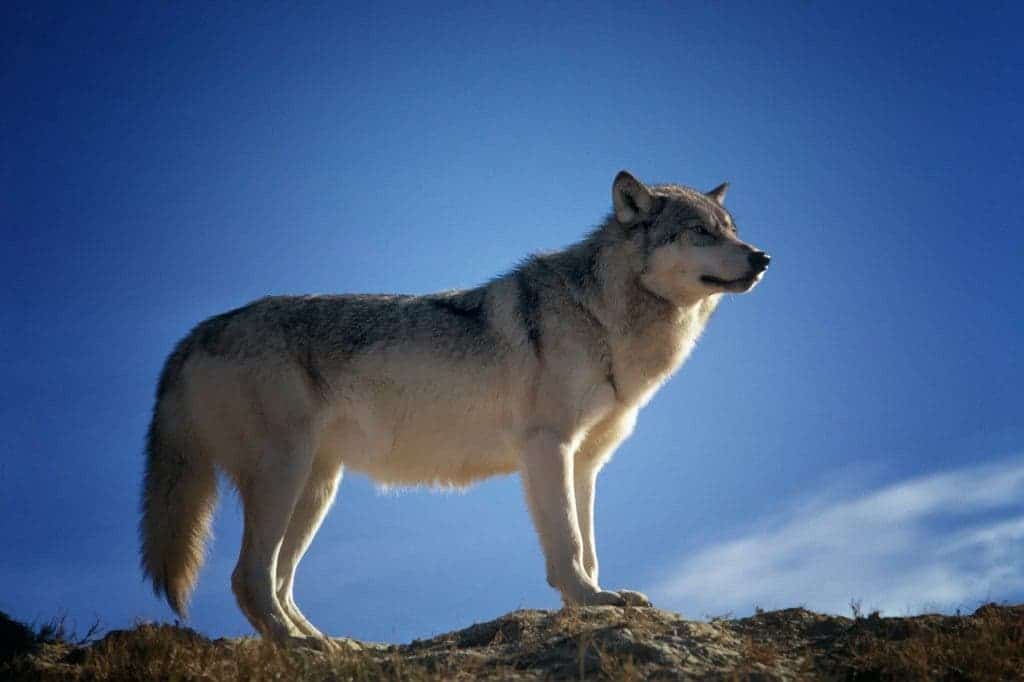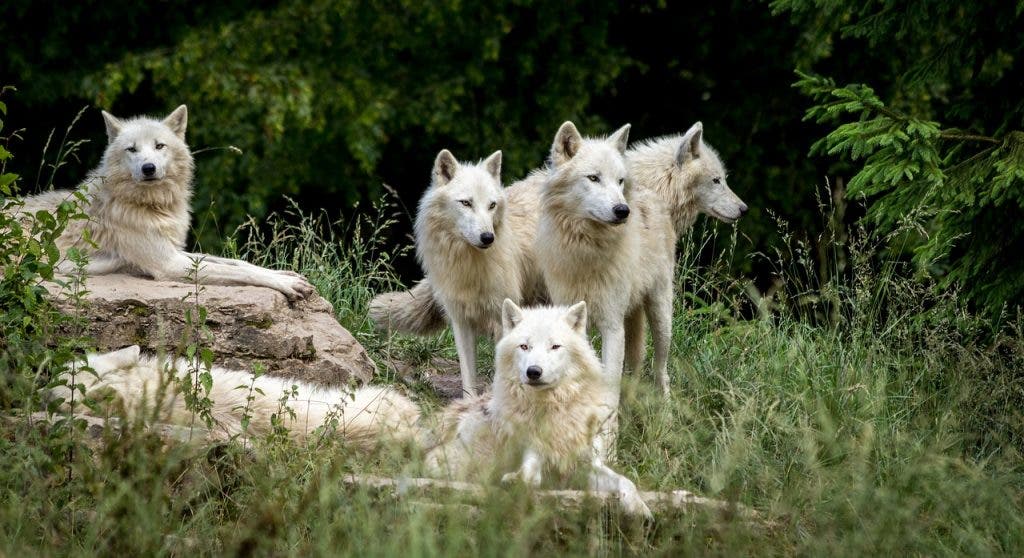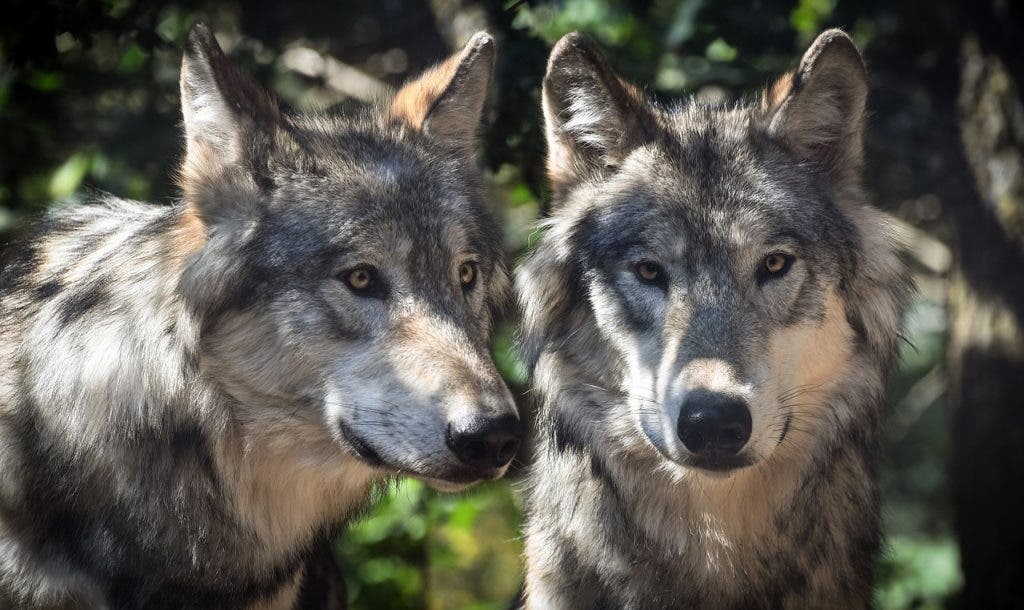
In the 1940s, researchers studying wolf packs noticed that they formed strict strength-based hierarchies were a dominant male and a dominant female controlled the other individuals, deciding the order in which they were allowed to eat or mate. To describe this dominant pairs and subordinates, researchers introduced the terms ‘alpha’ (the chief), ‘beta’ (the debuty), or ‘omega’ wolf (the bottom of the rank). Later, these terms became ingrained in human consciousness and cultural lingo to describe dominance hierarchies in other contexts, including humans.
But there’s a problem. This entire designation is wrong. While it’s true that multiple wolves who share a small space in captivity will develop alpha- and beta-like hierarchies, wild wolves behave nothing like this. In the wild, a wolf pack is typically formed by monogamous parents and their puppies. Sometimes, the pack might also include older siblings aged one to three years old. That’s it.
The wolf pack is basically a tightly knit family unit consisting of “parents”, or “breeders”, and their offspring. Unless you’re ready to call your mom and dad ‘alpha’, these terms have no grounds in reality.
Where did the idea of ‘alpha’ wolves come from?

The notion of leading wolves that control a pack of subordinates can be traced to 1947, when Rudolf Schenkel wrote a paper titled Expressions Studies on Wolves, in which he described the behavior of ten wolves kept at the Basel Zoo in Switzerland in a relatively small pen about 10 by 20 meters. During his observations, Schenkel noticed that the highest-ranked males and females formed a pair.
“By continuously controlling and suppressing all types of competition within the same sex, both ‘alpha animals’ defend their social position,” Schenkel wrote.
The pack behaviors described by Schenkel, including the ‘alpha’ dominance hierarchy, proved highly influential and were picked up by other ecologists, including David Mech, the founder of the International Wolf Center and one of the world’s foremost experts on wolf ecology.
Mech published a book called “The Wolf: Ecology and Behavior of an Endangered Species,” written in 1968, which proved immensely popular and further ingrained the concept of the alpha wolf in the niche literature, with many other researchers citing the book. Other research performed in the 1960s and 1970s, all on wolves held in captivity, seemed to confirm the alpha wolf model.
But after he published the book, he noted that later studies on wolves in the wild showed that this model is outdated.
“That concept was based on the old idea that wolves fight within a pack to gain dominance and that the winner is the ‘alpha’ wolf,” Mech said.
“[The book was] republished in paperback in 1981, and currently still in print, despite my numerous pleas to the publisher to stop publishing it. Although most of the book’s info is still accurate, much is outdated. We have learned more about wolves in the last 40 years than in all of previous history,” he added.
Like other debunked or misinterpreted science that is somehow still popular, such as Darwin’s survival of the fittest (misunderstood by many as ‘the strongest are favored by nature to survive’) or John Locke’s Tabula Rasa, the alpha wolf is perhaps more widespread in popular culture than ever.
Why there are no alpha wolves

One of the implications of the ‘alpha’ of the pack is that individuals compete with others to become the top dog, typically through battle.
However, in the wild, the leading members of a pack are the breeders of the offspring. In other words, the vast majority of wolves that lead packs earn their position simply by mating and producing pups. For this reason, scientists now call leading wolves the “breeding male,” “breeding female,” or “male parent,” “female parent,” or the “adult male” or “adult female.”
This has been confirmed by many recent studies, including two papers published by David Mech in 1999 and 2000, who extraordinarily managed to make a wolf pack from Ellesmere Island in Canada acclimatize to his presence over the course of 13 summers. Mech was able to study the pack up close, sometimes from up to a meter away. “Dominance fights with other wolves are rare, if they exist at all. During my 13 summers where I observed the pack, I saw none,” Mech wrote in one of his articles.
Elsewhere, in Norway, Barbara Zimmermann and colleagues from the Inland Norway University of Applied Sciences studied wolf pack behavior using GPS devices. The typical Scandinavian wolf pack consists of six members, usually two parents and four puppies. The parents establish their territory by marking a large area of the forest with their scent, and then patrol and defend their territory from intruders.
During February and March, the wolves mate and offspring are born in May. While the female nurses the young in her den for the first couple of weeks, only the male hunts. The male parent eats as much prey as possible then comes back to the den and vomits food for the female to eat. Then, they switch roles, with the female going out to hunt and bring back food while the male guards the den.
“What is exciting about wolf pairs is that they are unbelievably faithful. They stay together all the time,” Zimmermann told Science Nordic, describing the monogamous nature of wolves.
“More than 70 percent of GPS positions from wolf pairs show they remain within 100 meters of each other. So they are incredibly dependent on each other,” she added.
By October, the offspring are big enough to follow the adults around, although they are not allowed to hunt. The pups get to eat whatever prey the adults bring home to the den in the evening. This is yet another dispelled notion of the alpha wolf pack, which suggests a pack of wolves hunts in teams and moves together at all times. In reality, the young wolves are gradually weaned off and typically hunt on their own when they leave the pack to establish their own families.
Most pups leave the pack when they are one year old. This usually happens in waves, with 1-2 pups leaving early, while the rest are forced to finally leave the pack when the parents make new offspring.
The young wolves go out in search of a mate and suitable area to claim as their own territory. In some situations, young wolves are allowed to forage in their parents’ territory for up to two more years.
In other places, such as Yellowstone National Park where wolves were reintroduced in 1995, the packs can be larger and several members may hunt together. But even these packs are exclusively formed of parents and offspring. It’s just that some are as old as four years of age. This situation is enabled by the fact that Yellowstone has a much higher prey density than other regions where wolves are endemic.
Other variations include packs where one of the deceased parents is replaced by a new partner, sometimes with cubs in tow. In larger packs, there may be situations where both mother and daughter give birth but the daughter is still subordinate to the mother, although she retains control of her own offspring. This latter situation may be the only instance where the term ‘alpha’ may be used.
However, in none of these outlined situations is there any evidence of strength-based dominance hierarchy that occupies the public’s mind. Instead, a wolf pack is a family unit where the parents (or in rare situations the grandparents) lead by virtue of being the ones that brought the rest of the pack to life.
Today, the term ‘alpha wolf’ is no longer in fashion among researchers specialized in wolf ecology. However, it is still in use in the vernacular and will probably remain so for the foreseeable future. Yet humans who subscribe to the idea of “alpha males” might want to keep in mind that this concept only applies to the behavior of captive and cornered creatures.
This article was originally published in July 2021.


